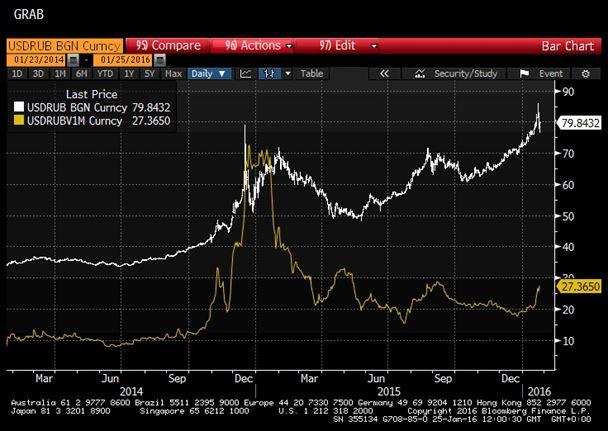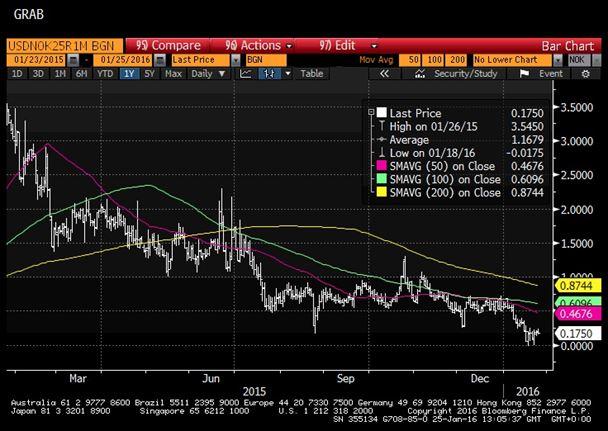- Price of oil the key factor driving global sentiment this year
- Crude prices, equity indices remain highly correlated
- Further fall in oil prices could see USDRUB vols spike
The rise came as Khalid Al-Falih, head of Saudi Aramco, spoke at The World Economic Forum in Davos. He mentioned that the company would not cut production and that a recovery in prices this year was "inevitable". In London on January 25, Opec secretary general Abdalla Salem El-Badri expressed concern over the low oil price and mentioned that both members and non-members of the group need to work to ensure prices move higher.
The oil price has had a remarkably direct correlation with equity indices in 2016. WTI crude oil futures suffered their biggest decline over a session so far this year when the price dropped 5.35% on January 6. On that day and the next, the Dow Jones Industrial Average index lost 644 points. Moreover, slowing growth in China has led the Bloomberg Commodity index to trade at an historic low, and this has caused trouble in Asian equities and stocks worldwide too.
Notice on the graph below the correlation below between the price of the aforementioned commodity index and the Australian stock exchange.
_20160125170104.jpg)
Source: Saxo Bank, Bloomberg
It goes without saying that global markets are inextricably linked, and the decline in demand for raw materials has hurt currencies reliant on such exports (the Aussie and Kiwi dollars to name just two).
The oil price move has impacted currencies with economies reliant upon global appetite for "black gold". In the second half of 2014, oil prices almost halved from $100/b. Russia is the second largest oil producer in the world after Saudi Arabia, and USDRUB moved dramatically towards the 79.0 figure at this time, particularly after the central bank in Russia raised the benchmark interest rate for the nation from 10.5% to 17.0 in response.
The spot pair at nearly 80.0 now in a nervous market, but volatility hasn’t moved in the same fashion. Below is a graph of spot USDRUB over the last two years as well as the volatility of the one-month straddle for that pair. Ultimately, the options are sensitive not just to price but to volatility too. A base interest rate rise of 6.5% would definitely cause this, and the spot move can be seen to be more pronounced than those of the last six to nine months.
Traders may still view USDRUB options as cheap, however, where volatilities and thus premiums have remained relatively stagnant over this time. Sentiment can be a driving factor, and should the oil price head towards $10/b, panic may lead volatilities in this currency pair to levels seen two years ago.

Source: Saxo Bank, Bloomberg
An extraordinary meeting was held in Norway yesterday between the prime minister, the finance minister and the Norges Bank governor. The national reliance on demand for oil and the market price thereof was the only topic on the agenda.
Norway is the largest oil exporter in Europe and one of the most prominent worldwide. The central bank is ready to lower the base interest rate further from the current level of 0.75% to compensate for the difficulties. The weaker NOK trades currently at around the 8.75 mark versus the greenback.
Initially, it may come as a surprise to notice on the graph below that the one month 25-delta risk reversal has moved significantly lower over the past year...

Source: Saxo Bank, Bloomberg
Taking a look at current premiums for options on oil, however, the pricing of the risk-reversal makes some sense. Indeed, USDNOK spot has moved higher, but there are fewer buyers of USD calls than there were a year ago. Furthermore, the price of a call option on the WTI crude oil future is far higher than that of a put.
There is downside risk to oil, of course, but the options market still sees more value in the $40 and $50 strikes than those at $20 and $10. Hence, the possibility of a move lower in USDNOK is higher despite the price action of late, and thus the risk reversal above has moved towards par.
Lastly, in terms of USDSAR there have been increasing flows in the currency pair with buyers amongst the interbank market of interest rate and currency options. Volatility has recently risen from 0.5% to 3.25% in the one-month currency straddle on the rumour that the USD peg will become a thing of the past.
The same can be said for other currencies, including HKD and AED. The oil price has always been a key driver of financial markets and it appears to be more important than ever at the moment.
As tensions in the Middle East continue to a rise, particularly between Sunni Saudi Arabia and Shia Iran, the precise level that crude oil trades at could be a matter of dollars away from moving markets in one direction or the other.
The products offered by Saxo Markets UK Limited ("SCML") include but are not limited to Foreign Exchange, Stock, Index and Commodity CFDs, Options and other derivative products. These products may not be suitable for all investors, as trading derivative products carries a high level of risk to your capital. It is possible to lose more than your initial investment so before deciding to trade you should ensure you understand the risks involved and seek independent advice if necessary.
Recommended Content
Editors’ Picks
EUR/USD clings to gains near 1.0700, awaits key US data

EUR/USD clings to gains near the 1.0700 level in early Europe on Thursday. Renewed US Dollar weakness offsets the risk-off market environment, supporting the pair ahead of the key US GDP and PCE inflation data.
USD/JPY keeps pushing higher, eyes 156.00 ahead of US GDP data

USD/JPY keeps breaking into its highest chart territory since June of 1990 early Thursday, recapturing 155.50 for the first time in 34 years as the Japanese Yen remains vulnerable, despite looming intervention risks. The focus shifts to Thursday's US GDP report and the BoJ decision on Friday.
Gold closes below key $2,318 support, US GDP holds the key

Gold price is breathing a sigh of relief early Thursday after testing offers near $2,315 once again. Broad risk-aversion seems to be helping Gold find a floor, as traders refrain from placing any fresh directional bets on the bright metal ahead of the preliminary reading of the US first-quarter GDP due later on Thursday.
Injective price weakness persists despite over 5.9 million INJ tokens burned

Injective price is trading with a bearish bias, stuck in the lower section of the market range. The bearish outlook abounds despite the network's deflationary efforts to pump the price.
Meta takes a guidance slide amidst the battle between yields and earnings

Meta's disappointing outlook cast doubt on whether the market's enthusiasm for artificial intelligence. Investors now brace for significant macroeconomic challenges ahead, particularly with the release of first-quarter gross domestic product (GDP) data on Thursday.